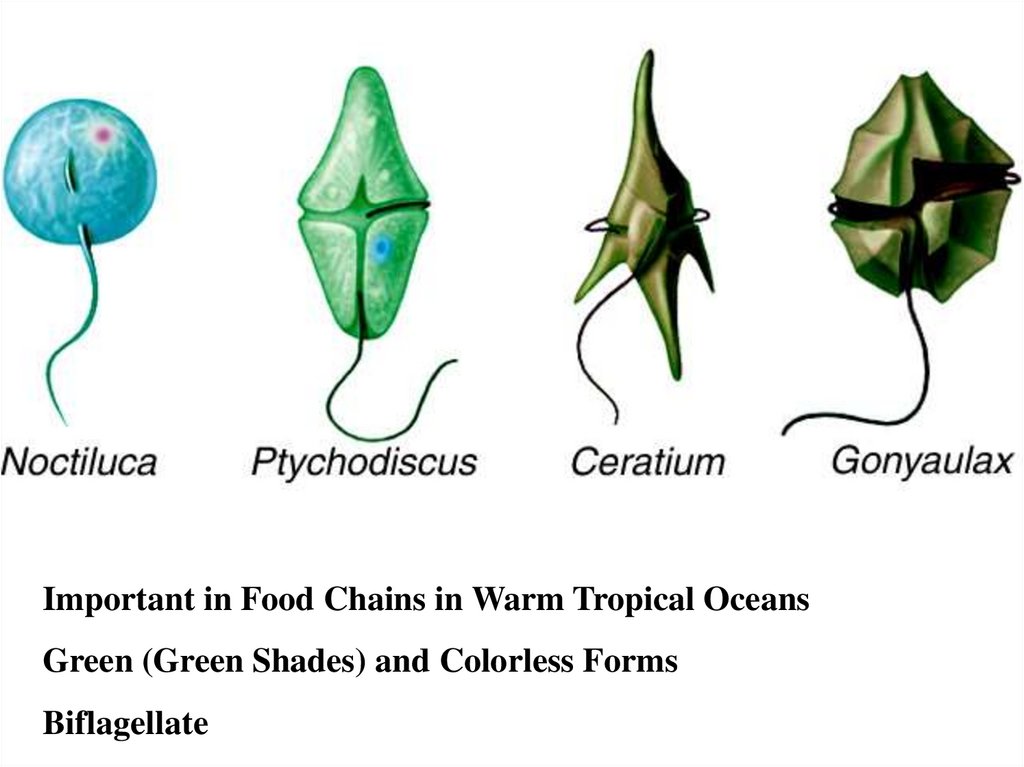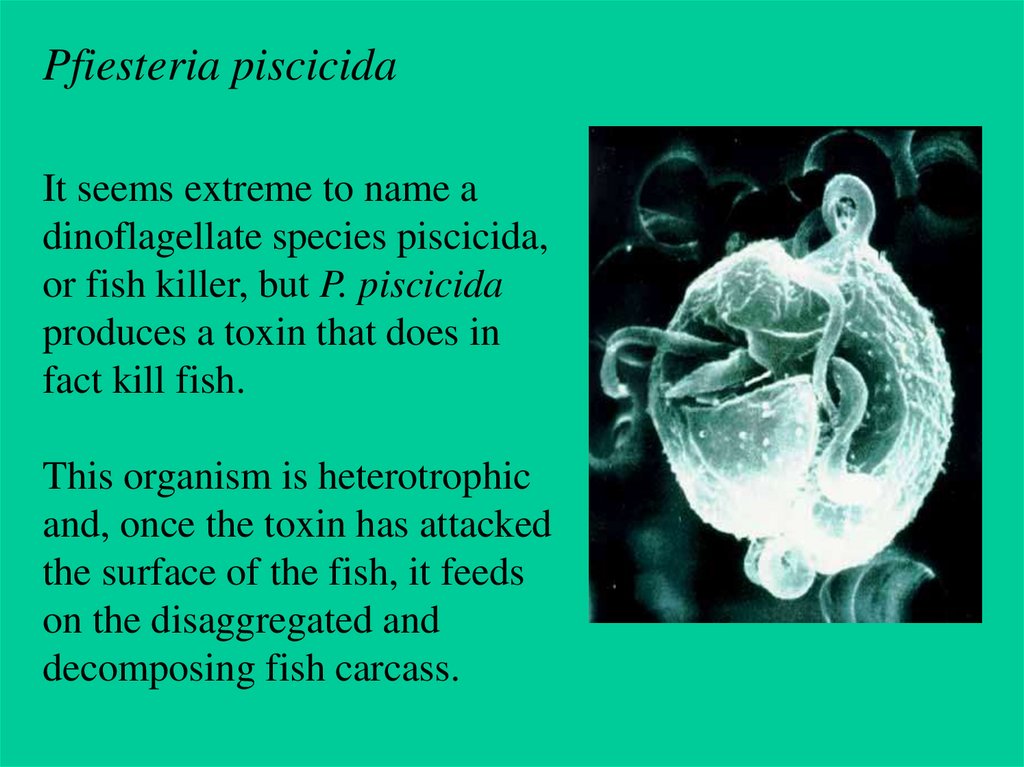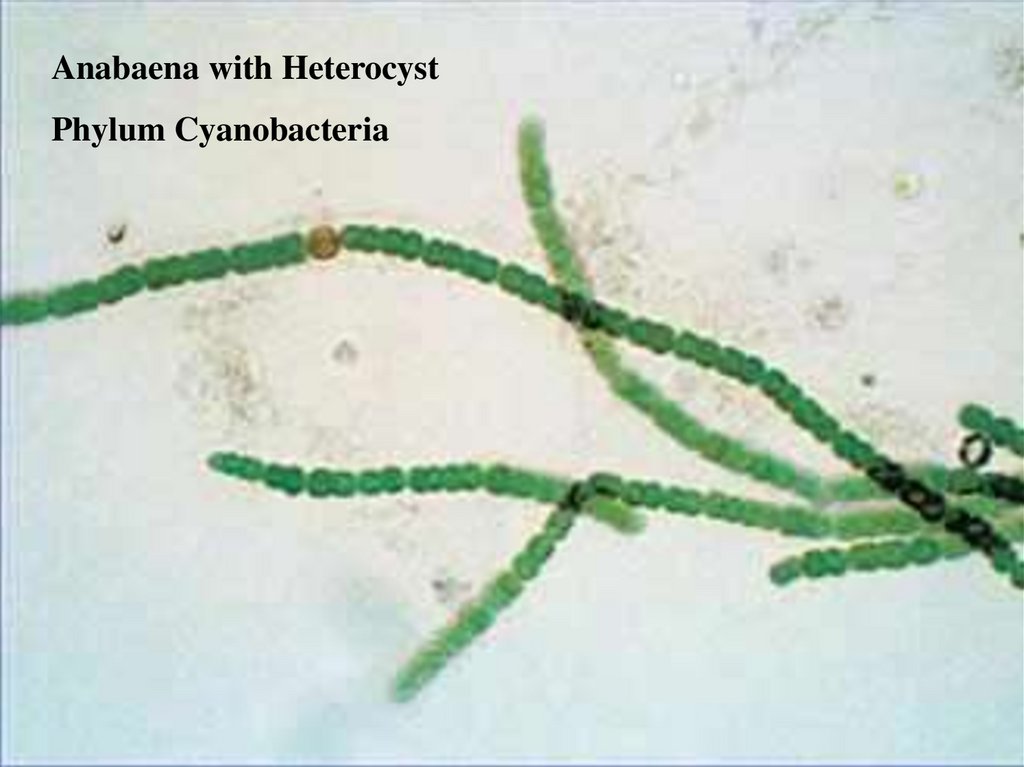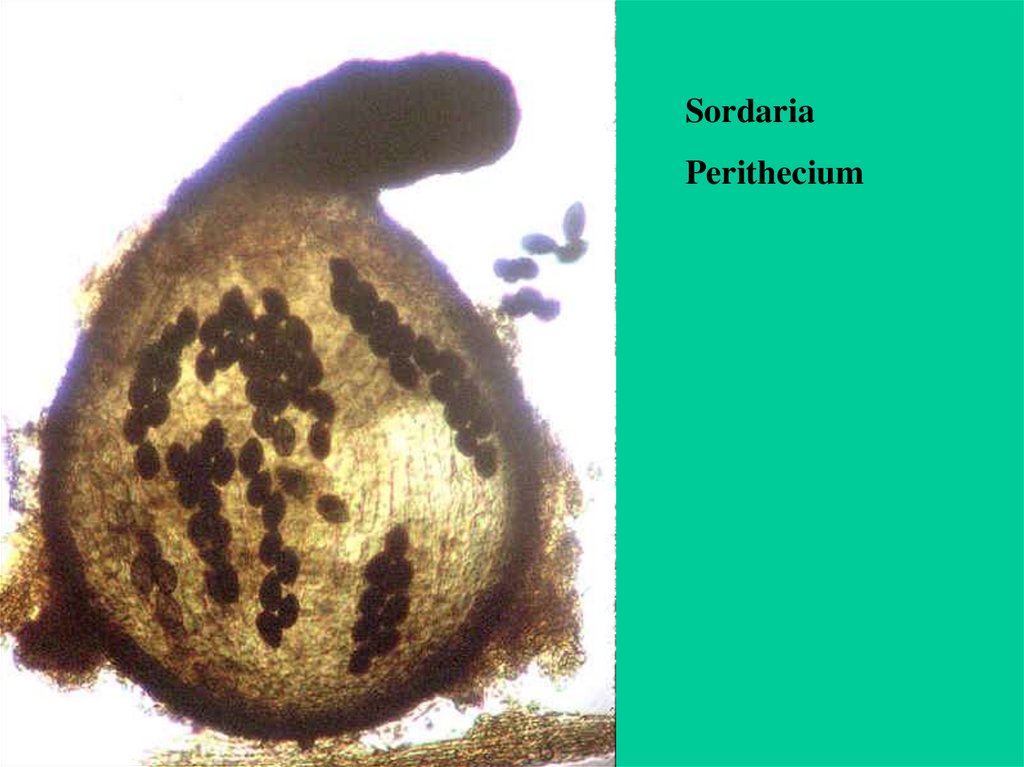Similar presentations:
Algae. Characteristics
1. Algae
1.Characteristics2.Red Algae Rhodophyta
3.Diatoms Bacillariophyta
4.Brown Algae Phaeophyceae
5.Dinoflagellates Dinophyta
6.Green Algae Chlorophyta
7.Other Algae
2. Characteristics
• Eukaryotic• Mostly Photosynthetic
(Photoautotrophs)
• Require Moisture
• Microscopic and Macroscopic
• Accessory Pigments Give Color
• Lack Vascular Tissue
• Sexual and Asexual Reproduction
3. Red Algae Rhodophyta
Extremely Old / > 2 Billion Years
4000 Species
Tropical and Warm Waters
No Flagella
Phycoerythrin
Irish Moss (Chondrus crispus)
Nori (Pyropia yezoensis, P. tenera)
Coralline Algae (Corallinales)
4.
Red algae , pigmentphycoerythrin reflecting red
light and absorbing blue light
Blue light penetration of water,
to a greater depth than light of
longer wavelengths
Phycoerythrin , red algae to
photosynthesize and live at
somewhat greater depths
5.
Reef-buildingrhodophytes ,
coralline algae,
secreting a hard shell
of carbonate around
themselves, in much
the same way that
corals
Corallinales
Gelidium amansii
6.
Ability to secrete calcium carbonate,calcareous red algae, better fossil record
than other of algal protists
Most limestone deposits of reef origin,
skeletons of coralline algae, association
with petroleum deposits
7.
Giant clam encrustedwith coralline red
algae
8.
Agar Comes from Red Algae9. Agar
- thermally reversible gels at lowtemperatures
- medicine
- bacteriology and mycology
- stabilizer for emulsions,
- cosmetic industry
- photographic film,
- shoe polish,
- shaving soaps, hand lotions,
- tanning industry
- confectionery
10.
• Nori is a red algae that serves as a source offood.
• High vitamin and protein content.
• Common in Japan
11. Diatoms
Largest Group / Recent Group
Phylum Baciollariophya
Cool Marine Environments
Food Chains / Phytoplankton
Silica Shells or Frustules
Asexual and Sexual
Diatomaceous Earth
Centrate / Pennate
12.
Largest Group of AlgaeFairly Recent Group: Very Important in Food Chains as Phytoplankton.
13.
Diatomaceous Earth is a non-toxic, safe substance made up fromcrushed fossils of freshwater organisms and marine life. Crushed to
a fine powder and observed through a microscope, the particles
resemble bits of broken glass. Deadly to any insect and completely
harmless to animals, fish, fowl or food.
14.
Diatoms are found in Cool Marine Oceans.They are composed of beautiful Silica Shells that
allow them to sparkle and shine upon viewing.
Pictured is a Pennate Freshwater Diatom
15.
Centrate Diatoms areUsually Found in
Marine Environments
16.
Reproduction is Asexual for SeveralGenerations and then Sexual for Genetic
Variation.
17.
Diatoms are often found with Desmids. Desmids are single-celled greenalgae which can only be found in fresh water
18.
19. Brown Algae
Related to Diatoms
Rocky Coasts in Temperate Zones
Cold Open Seas
Multicellular Only
Brown / Fucoxanthin
Laminaria / Sargassum
Alginic Acid / Iodine
Phylum Phaeophyta
20.
Young Group CloselyRelated to Diatoms
Found in Rocky Coasts in
Temperate Zones or Open
Cold Seas
21.
Multicellular AlgaeAttain Great Size – 180 Feet Growing 2 Foot/Day
Cell Walls are Cellulose and Algenic Acid
22.
Kelp bed located near Monterey, California23.
Structure ofKelp
Kelp are the only
Algae known to have
internal tissue
differentiation into
conducting tissue.
24.
Regardless of the typeof picture provided, you
should be able to label
each of the following:
Blade
Holdfast
Air Bladder
Stipe.
25.
26.
27.
28.
They may be small, but sea otters play a big ecological role in theNorth Pacific. Sea otters feed on urchins, which in turn consume
kelp. Without otters, sea urchins destroy kelp forests that provide
vital habitat for many marine organisms.
29.
LaminariaLaminaria is an herbal
medicine used to induce
labor and abortion. The
dried stem of Laminaria
mechanically dilates the
cervical opening by
absorbing water and
swelling to several times its
original diameter. Laminaria
is a marine algae which
provides a good source of
protein, vitamins, minerals,
and carbohydrates. It only
contains small amounts of
fat.
30.
31. Alginic Acid
• An insoluble colloidal acid in the form of apolysaccharide that is abundant in the cell walls of
brown algae.
• Used in jam, jellies and marmalades and other
similar fruit spreads including low-calorie
products
• An ingredient in antacid preparations.
32. Alginic Acid
• Alginates are also used as a thickeningpaste for colors in printing textiles, as a
hardener and thickener for joining
threads in weaving; the alginates may
subsequently be dissolved away, giving
special effects to the material. Other
uses include glazing and sizing paper,
special printers' inks, paints, cosmetics,
insecticides, and pharmaceutical
preparations.
• In the USA alginates are frequently
used as stabilizers in ice cream, giving
a smooth texture and body, and also as
a suspending agent in milk shakes.
Alginic
Acid
33. Dinoflagellates
Warm Tropical Oceans
Unicellular / Green or Colorless / Biflagellate
Unusual Nucleus
Bioluminescent
Asexual Reproduction
Food Sources / Parasitic
Red Tide / Ciguatera
Paralytic Shellfish Poisoning
34.
Important in Food Chains in Warm Tropical OceansGreen (Green Shades) and Colorless Forms
Biflagellate
35.
Chromosomes are Always VisibleDivers out for a night dive can sometimes see each
other just by the ghostly glowing outline of the
bioluminescent phytoplankton. Bioluminescent
dinoflagellates have even made boats visible against
the darkness!
36.
As large as 2 mm or microscopic37.
Reproduction is typically asexual accomplished by splitting of thebody and new individuals remain for some time attached to the first
one as shown in the picture.
38.
Photosynthetic Food SourceForms Parasites on Fish and Some Protists
39.
Like other phytoplankton, Dinoflagellates go through bloom cycleswhen they are highly abundant and these blooms can be toxic
(commonly called red tides).
Red tide - a discoloration of sea water
caused by an explosive growth in phytoplankton density:
sometimes toxic to fish life and, through accumulation
in shellfish, to humans
40.
41.
Red Tide Off Coast of California42.
43.
Pfiesteria piscicidaIt seems extreme to name a
dinoflagellate species piscicida,
or fish killer, but P. piscicida
produces a toxin that does in
fact kill fish.
This organism is heterotrophic
and, once the toxin has attacked
the surface of the fish, it feeds
on the disaggregated and
decomposing fish carcass.
44.
• This species has beenimplicated in a large
fraction of sudden fish
kills in North Carolina
estuarine waters in recent
years, particularly in
Pamlico Sound, which is
the second largest estuary
on the east coast of the
United States.
• Toxic algal blooms are on
the rise throughout the
world in recent years
45.
46. Green Algae
Second Largest Group
Most Diverse
Very Old
Freshwater / Moist Soil
Sea Lettuce
Single Cells / Filaments / Colonies / Thalli
Source of Oxygen / Food Chain
Volvox, Spirogyra
Freshwater / Volvox, Spirogyra
Marine / Sea Lettuce
47.
Second Largest Group of Algae.Most Diverse of all Algae
Found in Freshwater and on Land
48.
Almost as Old as Red Algae49.
Variety of Forms Including Single Cells, Filaments,Colonies, and Leaf-like Thalli
50.
Can StoreStarch
Much in the
Same Way
as Plants
and also
may have
Cellulose in
Cell Walls
51.
Scientists Concludethat Higher Terrestrial
Plants Arose from a
Green Algal Ancestor.
Sea Lettuce is a Marine
Species that Lives in
Salt Water along the
Coast. It forms in
Sheets and Often
Obscures the Bottom.
52.
Spirogyra (Freshwater Species)53.
Conjugation Tubes are a Means of Sexual Reproduction.54.
• Algae are simple plant organisms found in all wetenvironments.
• They range in size from microscopic forms to the simple
macroscopic forms of 'pondweeds', and the large
seaweeds.
• All are interesting to study but microbiologists generally
agree that one of the most beautiful to behold is Volvox.
55.
Volvox56.
Daughter Cells Visible Inside Volvox57.
• These are sphericalcolonies of green
cells clinging to a
semi-transparent
hollow ball of
mucilage. A single
colony may consist
of over 500 cells,
each one with a tiny
pair of whip-like
tails (flagella) - and
all cells undulating
their flagella in
unison, propelling
the colony through
the water.
58.
A single Volvox colony spins through the dark waters of a pond.Daughter cells are just visible inside.
59. Other Algae
60.
Anabaena with HeterocystPhylum Cyanobacteria
61.
SordariaPerithecium
62.
Sordaria Ascuswith Ascospores
































































 biology
biology








